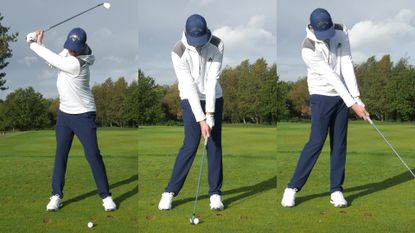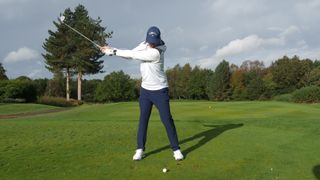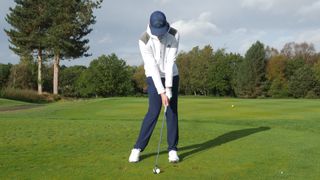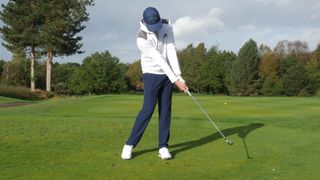What Is The Release In The Golf Swing?
We explain the release in the golf swing and share a simple drill to make yours better


Release in the golf swing is a phrase often used in golfing parlance, but it can cause confusion for a lot of people. In this video and article below, PGA pro Ben Emerson runs through everything you need to know...
Contrary to popular belief, releasing the club doesn’t simply mean chucking the hands through impact and letting the toe turn over aggressively. Rather, golfers should think of it as a way of releasing power through the body, club and into the ball at the correct moment. You want it to be something that occurs naturally and as a positive consequence of what’s come before.
RELATED: Best golf irons
There are a couple of common faults among amateurs that can lead to an inefficient release. One of them is known as casting, whereby the angle created between the arms and the club is released too early, resulting in a scooping motion at impact - this is such a power-killer.

Casting the club from the top of the swing will result in a loss of power and accuracy
A good drill to hone an effective release pattern can be done by placing a tee into the ground a few feet in front of the ball. From there, you’re going to rehearse a good impact position with the hands forward and the hips slightly open, before working on a few half-swing punch shots.

This is what a good impact position looks like
Crucially, you should not be trying to hit ‘at’ the ball. Get the sequence right and the club will breeze through impact, accelerating as it goes - this is one of the most important elements in how to swing a golf club. Swing back until your lead arm is parallel to the ground, then swing through and try to stop when the clubhead is pointing at the tee. Don’t worry if it takes a few attempts to achieve the desired position; by simply working towards that goal, you’ll be improving your release and sequence as a byproduct.

When doing this drill, you want to get the club pointing at the tee shortly after impact
For every five balls, do the drill a few times and then hit one or two full shots during a practice session. If you dedicate yourself, you’ll start to notice improvements pretty quickly. The beauty of it is not just in its simplicity, but in the fact it can have a profound impact on your entire swing as well as how you deliver the club.
Get the Golf Monthly Newsletter
Subscribe to the Golf Monthly newsletter to stay up to date with all the latest tour news, equipment news, reviews, head-to-heads and buyer’s guides from our team of experienced experts.
RELATED: Most popular drill on tour
So, if this is something you’ve struggled with, work on these pointers and enjoy crisper strikes that send the ball further and straighter.

Location: Sand Martins GC
Ben’s modern approach to golf coaching has seen him become one of the most sought-after coaches in the country and teaches none other than Robbie Williams. His honest, modern and fun style of coaching has help thousands of golfers of all ages and abilities and he has been coaching for over 20 years.
Advice for practice:
Start with slow, small swings. If you can’t do it small and slowly there is not a hope in hell of doing it at full speed with a full swing! In other sports such as rugby or martial arts they slow learn new moves/plays before making them at full speed.
Teaching philosophy:
‘Why guess when you can access’ Ever new student goes through a full TPI movement screen, 3D motion capture and pressure plate analysis as well as TrackMan and 2D video analysis. Coaching is based on facts and not guess work.
Most common problem:
A lack of clubface understanding and awareness. I get golfers to aim the clubface directly at the target and get them to make a slow swings and deliver the club to the ball with an open face, then repeat the same thing again but with a closed face, followed by one at the target. Giving them full awareness based on feelings errors to find a happy middle ground.
-
 How My First Solo Golf Holiday Opened My Eyes To An Emerging Golf Haven
How My First Solo Golf Holiday Opened My Eyes To An Emerging Golf HavenLast year, I flew solo on a golf trip to Turkey. My experience taught me a lot about the joys of solo traveling and opened my eyes to an under appreciated golf haven
By Dan Parker Published
-
 Stuburt Evolve Classic Hybrid Golf Shoe Review
Stuburt Evolve Classic Hybrid Golf Shoe ReviewHow did the Stuburt Evolve Classic shoe perform on the course? We tested it out to find out.
By Roderick Easdale Published